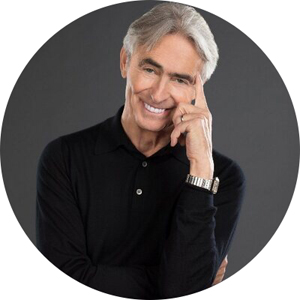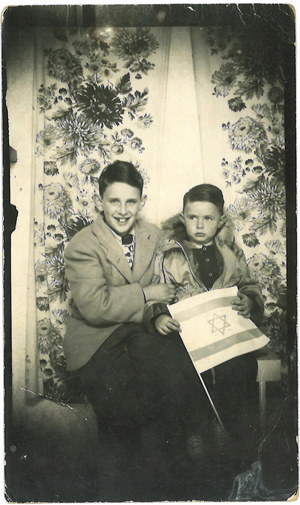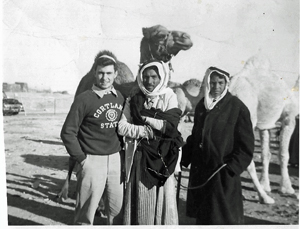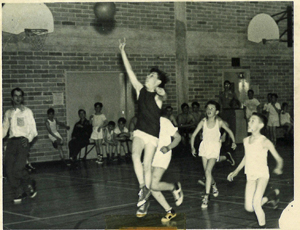Features
David Steinberg speaks fondly of his Winnipeg roots in autobiography
 By MARTIN ZEILIG When asked why he decided to write this entertaining and insightful book comedian/director/writer/producer/actor David Steinberg provides a concise and reasonable response.
By MARTIN ZEILIG When asked why he decided to write this entertaining and insightful book comedian/director/writer/producer/actor David Steinberg provides a concise and reasonable response.
“Money,” Steinberg said in an email response to a series of questions sent to him by this reporter.
He seems to be following, at least in part, the wise words of Samuel Johnson (Dr. Johnson) the 18th century English writer, moralist, critic, editor and lexicographer who famously said, “No man but a blockhead ever wrote except for money.”



David as a youngster in Winnipeg
Left: David (right) with his older brother Fishy, in 1946
Top right: David in Israel while on a scholarship to the Hebrew University
Bottom right: David playing basketball at the YMHA on Hargrave, 1953
But, to be fair, there was more to Steinberg’s reply: “And I have a lot of memories and information about comedy and comedians I wanted to share.”Steinberg grew up in Winnipeg, where he studied theology at yeshiva at the age of fifteen, and went to the University of Chicago, leaving to become a member of Second City, notes his bio.
He appeared on Broadway with Elliot Gould in Jules Feiffer’s Little Murders and Carry Me Back to Morningside Heights, directed by Sidney Poitier. During Steinberg’s almost three decades as a stand-up comedian, beginning at the Bitter End, he released four comedy albums and received two Grammy nominations. Steinberg has directed many TV shows, among them Seinfeld, Curb Your Enthusiasm, Designing Women, The Bob Newhart Show, and The Golden Girls. He lives in Los Angeles and New York with his wife, Robyn.
This writer has known David “Duddi” Steinberg for decades. His sister, Tammy Lazer, and her (late) husband, Harry, and their two children, Hart and Shelley, lived next door to the Zeilig family in Garden City for a number of years.
I have vivid memories of Hart and me playing football catch on Primrose Crescent with “Uncle Duddi” whenever he used to come visit the family. David drove a blue 1959 Plymouth Valiant.
On at least one occasion, he even visited my parents, Lillian and Morrey, and played his guitar and sang a folk song while sitting on the orange shag carpeted living room floor of our five room blue bungalow.
While watching David on a television comedy special from Hollywood many years later, my mother reminisced about that special time when the young “still undiscovered” Duddi Steinberg had serenaded her.
I recall a standup comedy show Steinberg gave at the Centennial Concert Hall back in the late 1970s. Afterwards, he invited some friends, including my mother, and family members backstage to visit him in his dressing room for a while.
As someone said afterwards, “Fame and success hasn’t changed him. Duddi Steinberg is still a real down-to-earth mentsch.”
My late brother, Ken, worked as a radio arts correspondent for CBC in London, England for many years back in the 1960s and ‘70s. I recall him telling me that he and his first wife, Gillian, saw a play in the west end, which had first appeared on Broadway, starring Steinberg.
“The play wasn’t memorable,” Ken said. “But, David is an engaging actor. He’s very good.”
Steinberg writes that it took him a few years to write the book—all the stories, reminiscences, tales of directing, performing and related anecdotes and incidents—to get it “where I wanted it.”
The list of comedians in the book seems endless, from Sid Caesar and Mel Brooks, to Don Rickles, Lucille Ball, Rodney Dangerfield, Richard Pryor, Robin Williams, Billy Crystal, Lily Tomlin, Ben Stiller, Chris Rock, Martin Short, Steve Martin and so many more.
“We didn’t have TV in Winnipeg while I was growing up,” the author writes.
“I watched every movie as a kid and listened to every radio show. Radio was so exciting. It was all about your imagination. You were creating pictures in your head from what you were hearing. I always applied that to my stand up. Second City (the Chicago comedy and improvisational troupe) was one of the best things that happened to me early on.
“I learned from seeing Lenny Bruce perform at the Gate of Horn that a comedian could be dapper and still be funny (rare for the time). Lenny was a genius. He was soft-spoken and never pandered to the audience. He was never afraid of being controversial. He was my comedic hero. He was everyone’s comedic hero.”
He also considers being on The Tonight Show Starring Johnny Carson for over 30 years as a major highlight of his career.
“Johnny asked me to host it when I was 26,” Steinberg says. “Looking back, being on that show with Johnny was everything to me. I love comedians and I love my life in comedy. I loved directing all the shows from Bob Newhart to Curb Your Enthusiasm. And I’m so proud of this book.”
Yet, in looking back at his long and illustrious career, Steinberg says that “Getting the Order of Canada (presented by former Governor General Her Excellency the Right Honourable Julie Payette) was one of the most important moments in my life. Remember, my father (a rabbi/grocer) and mother were Russian immigrants, with very little. My only regret is that they were not there to see me get one of the highest honors of my beloved country.”
Some notable excerpts: “Insecurity combined with arrogance is good DNA for a comedian. So is anger, aggression, and sadness. If you’ve had a great life and a wonderful bar mitzvah and you’ve been given a lot of money, you’d make a lousy comedian. You’re better off being the comedian’s lawyer.
“…I may be the only comedian to have made Elie Wiesel laugh; that I was admired by the great New Yorker writer S.J. (Sid) Perelman, and by Philip Roth, Kenneth Tynan, and Harold Pinter. And that I was virtually adopted by Groucho Marx and many of the legendary old-timers (such as Jack Benny and George Burns) at Hillcrest Country Club. I also directed Burt Reynolds at the height of his considerable fame, before he self-destructed.
“It’s a funny thing about comedy: when you give your life to it, it can become a serious business. I spent my life in and outside the comedy world, and it is a world, a universe unto itself.
“But this book is not just about my life in comedy—it’s about my life and comedy in the last half century. I lived through a time when stand-up comedy was a poor relation to other forms of entertainment, when being on a successful sitcom was nothing to write home about. But, I think I was one of a group of people—along with Steve Martin, Richard Pryor, George Carlin, and a few others—who pushed stand-up forward as an art form and made comedy an important part of the culture.
“Comedians ‘steal’ from each other all the time—not material, but ideas. There’s no good comedian that hasn’t stolen ideas from someone. And you don’t really ‘steal’ material. You do your own version of it. And so that’s a bar code. So Shelley Berman on the phone—I guarantee you Nichols and May had their comedic ‘on the phone’ piece before him. Bob Newhart was on the phone in a way no one else was.”
Then, there was the time Steinberg was best man at the wedding of the notorious Mafia kingpin Joey “Crazy Joe” Gallo.
He writes: “Joey Gallo was about forty years old when we met and about as famous in his own high-visibility field as I was in mine.”
Caption under a photo— one of many photos— in the book: “I hadn’t known Joey Gallo that long, maybe a year or so, but I arrived at Jerry and Marta Orbach’s house for a party, and when I got there, I was told that Joey and Sina were getting married right then.When Joey insisted I be his best man, the priest was so excited I froze, surprised and shocked, as you can imagine. (I thought it should have been Jerry, who had known him for many, many years). And here I am right after the ‘I do’s’ with the happy couple. March 1, 1972.
“I remember, as a child, sitting in my neighborhood Winnipeg movie theatre all day, every weekend, watching the same Marx Brothers movies over and over again, and laughing and laughing and laughing, worshipping this great, odd, funny man with the funnier name, Groucho.
“Cut to eighteen years later, meeting my childhood hero, my new friend, Groucho. He could still make me laugh, but this time I could reciprocate the gift of laughter.”
David Steinberg’s life has, as he admits, been a dream built on laughter.
A legend in his field.
“Inside Comedy: The Soul, Wit, and Bite of Comedy and Comedians of the Last Five Decades”
By David Steinberg
(Knopf 335 pg. $40.00)
 Captions for above photos, as supplied by David Steinberg:
Captions for above photos, as supplied by David Steinberg:
Left: “On set with Jordan Peele (left) and Keegan-Michael Key (center). Many years ago, I directed Keegan in the pilot Frangela and subsequently became a big fan of Key & Peele. I was lucky to have Keegan and Jordan on Inside Comedy and to get to know these two amazingly talented people.”
Credit: Ty Watkins
Centre: “On the set of Inside Comedy. These are all people I love. They light up a room. Mel Brooks and Tim Conway are always buoyant, Jon Lovitz is so smart and just finished doing a perfect imitation of Woody Allen’s moose story, which he said inspired him into comedy. And my good friend Alan Zweibel, who is every comedy writer’s matzo brei. (Left to right: Brooks, Lovitz, Zweibel, me, Conway.) “
Credit: © Nicholas Rowan Adams
Right: One of my favorite birthdays with Don Rickles, Marty Short, Bob Newhart, and of course my wife, Robyn, who threw the party at E. Baldi restaurant in Beverly Hills, August 9, 2014.”
Credit: Courtesy of the Author

Captions for above photos:
Left: “Sharing a cigar with Groucho, as we always did. He was reluctant to come on as my co-host, but I’m so glad he did; it really meant everything to me, and the audience loved him.”
Credit: The Music Scene
Centre: “John Candy and his family lived in my guesthouse in Los Angeles for a year while we were writing and shooting the cult classic Going Berserk, circa 1982. John wrote most of the script on a napkin. That should tell you something. That was the whole script.”
Credit: Courtesy of the Author
Right: “This is Kong (short for “King Kong”). Kong was my monologue go-to. Sometimes I would talk about current events, and I also would do a Dietrich-like rendition of “Falling in Love Again.” One of the many places Kong and I went was on The David Steinberg Show, the CBS summer replacement for The Carol Burnett Show, 1972.”
Credit: Courtesy of the Author
Features
Is This the End of Jewish Life in Western Countries?

By HENRY SREBRNIK “Globalize the Intifada” has been the chant echoing through streets since October 7th, 2023. It was never a metaphor, and we now see the gruesome results across the western world, from Australia to Canada: the rise of groups of large, active networks of Islamist and anti-Zionist organizations.
Jews in the West are discovering that the nations they defended, enriched, and profoundly shaped have become increasingly inhospitable. After the Holocaust, explicit Jew-hatred became unfashionable in polite society, but the impulse never disappeared. The workaround was simple: separate Zionism from Judaism in name, then recycle every old anti-Jewish trope and pin it on “the Zionists.”
We have seen the full legitimization of genocidal anti-Zionism and its enthusiastic adoption by large segments of the public. The protests themselves, as they began immediately on October 7th, were celebrations of the Hamas massacres. The encampments, the building occupations, the harassment campaigns against Jewish students, the open calls for intifada, the attacks on Jews and Jewish places have become our new norm. History shows us that antisemitism does not respond to reason, incentive or the honest appeals of the Jewish community.
Outside the United States, there is no Western political establishment with either the will or the capability to address this problem, let alone reverse its growth. I’m sorry to say this, but the future of Western Europe, Canada, Australia, and New Zealand is likely to be increasingly Jew-free.
Today, police stand and watch mobs chant for Israel’s destruction, call for the genocide of its people, harass visibly Jewish citizens, and drive antisemitic intimidation deep into urban life. They now believe their job is to enforce the law only if it does not risk upsetting violent constituencies. This makes Jews expendable, because defending them risks confrontation. This was very clear in the Bondi Beach massacre.
Jews are again donning caps instead of kippot, dressing generically with no cultural markers, and avoiding even a tote bag with Hebrew on it. A corrosive creep toward informal segregation in retail and service sectors is occurring, as Jewish customers report being refused service. A mezuzah hanging from a rideshare mirror leads to cancellations. When Jews express frustration, they are accused of exaggeration or attempting to suppress criticism of Israel. Jewish fear is not treated as a real problem.
“Jews Are Being Sent Back into Hiding,” the title of a Dec. 15 article in the New York Free Press by David Wolpe and Deborah Lipstadt, asserts that the attacks on Jews, including physical assaults, social media campaigns and, most tragically, the recent murders in Australia, are part of a purposive campaign designed to make Jews think twice about gathering with other Jews, entering a synagogue, going to kosher restaurants, putting a mezuzah on the doorpost of their apartments or dorm rooms, or wearing a Jewish star around their necks.
“We know of no one who would consider giving a niece, nephew, grandchild, or young friend a Jewish star without first asking permission of their parents,” they write. The unspoken, and sometimes spoken, question is: “Might wearing a star endanger your child’s well-being?”
Recently, a prominent American rabbi was entering a Target store in Chicago with her grandson, whom she had picked up from his Jewish day school. As they walked into the store the 10-year-old reached up and automatically took off his kippah and put it in his pocket. Seeing his grandmother’s quizzical look, he explained: “Mommy wants me to do that.”
Borrowing a phrase from another form of bigotry, they contend that Jews are going “back into the closet.” No public celebration of Hanukkah took place in 2025 without a significant police presence. Some people chose to stay home.
Lipstadt and Wolpe know whereof they speak. They are respectively a professor of history and Holocaust studies who served as the Biden administration’s ambassador tasked with combating antisemitism, the other a rabbi who travels to Jewish communities throughout the world, and who served on Harvard’s antisemitism task force in the aftermath of the October 7, 2023 pogrom.
What the world has seen over the past two years is a continual, often systematic attempt to terrorize Jews. When political leaders fail to condemn rather than merely “discourage” chants of “globalize the intifada,” we are seeding the ground for massacres like the Hannukah one in Sydney.
If each Jewish holiday will now be seen by antisemites as an opportunity for terror, then the prognosis for diaspora Jewry is bleak. There will be fewer public events, more alarms, more bag checks at doors; there will have to be more security and more police. Unless things change, Jewish life in the diaspora will become more sealed off from the larger society.
Why has this failure come about? Confronting antisemitism, stopping the mobs, challenging the activists, and disciplining antisemitic bureaucrats all carry electoral risk for politicians; Jews are demographically irrelevant, especially compared with Muslim voters, with the U.S. being the only partial exception.
There are those who suggest Jews stop donating funds to educational and other institutions that have turned against us. At this point, I doubt very much that withdrawing dollars will have an impact. For every dollar withdrawn, there will be 100 from Qatar and other sources in its place.
Throughout history, the way a society treats its Jews predicts its future with unerring accuracy. If Jews leave, it will be because a civilization that will not defend its Jews will also defend next to nothing and may itself not survive.
Henry Srebrnik is a professor of political science at the University of Prince Edward Island
Features
Canadian Travel Trends 2025 and the Forecast for 2026

Canadians planning to travel in 2026 should keep an eye on shifting trends and learn what’s coming their way in the new year.
Canadian travel has seen a fair amount of change and instability over the last few years, thanks mostly to the country’s southern neighbours. In 2025, and likely into 2026, travel trends in the Great White North have stabilized significantly, with more Canadians than ever choosing to travel within their own borders. And with 2026 nipping at our heels, let’s take a look at what trends in 2025 have been the most prevalent and how these will shape travellers’ decisions and travel plans in the new year.
Canadian Travel in 2025
Thanks to many factors, including politics, inflation, and airline competition, the majority of travellers opted to explore their own country rather than go abroad in 2025. More local travel money is remaining within the local economy, further bolstering it and making it an even more attractive travel choice. Thanks to the accessibility of private jet charter travel across Canada, luxury local travel has increased as well, with more people looking to immerse themselves in luxury from the start of their journey to the end. When travelling abroad, the U.S. is now the least favoured destination for most Canadian travellers, but Europe saw a significant increase in interest as 2025 progressed.
As local Canadian travel increased this year, it brought with it a drive for local tourists to find their own “Secret Canada” destinations. Far more “off the beaten path” trips were taken, resulting in more travel spending going to smaller or more boutique destinations rather than big city experiences. In 2025, travellers have sought out the wonderful diversity in destinations and landscapes, allowing themselves to access more grounded and authentically Canadian experiences.
Canada’s Government has also encouraged and benefited from local tourism, with initiatives like the Canada Strong Pass offering extra benefits. Initially implemented in the summer, but reintroduced from December 12, 2025, until January 15, 2026, this is a ticket to enjoying the richness of their own culture (iconic natural destinations, museums, train trips) at a discounted rate or even in some cases free of charge.

In the second quarter of 2025, locals took a total of 90.6 million trips that included at least some time spent travelling domestically, which indicated a rise of 10.9% on a year-over-year basis. Of these trips, 58.6 million were day trip experiences (an increase of 12.4%), and 32.0 million were overnight trips or longer (an increase of 8.4%).
Between April and June of this year, Canadian residents spent $20.3 billion on local tourism, which represented a 13.5% year-over-year increase. When undertaking day trips, Canadians spent approximately $101 per visit. On overnight trips, locals spent around $449 per trip, with an average trip length of 2.6 nights. The Great White North is clearly holding its own, and then some, in the international travel market.
Canadian Travel in 2026
As we move towards 2026, many trends from 2025 will remain the standard, but some will evolve to fit changing demands. Across the board, though, the outlook for the coming year is that Canadian travel will become a far more personal thing, with trips being customized to fit travellers’ requirements and desires more closely than ever before. From choosing a hotel that they feel smacks of a beloved destination in their favourite novel, to taking a trip to a destination just to try a snack that’s famously made there and only there, travel is stretching and shifting for the traveller rather than the other way around.
Here are some slightly more specific predictions for the coming year based on the answers of polled Canadians.

- One Gen Z-led trend is the idea of “glowmad travel”. Beauty and skincare are now influencing the places that Gen Z travels, and their trips are far more likely to include visits to skincare and beauty destinations like spas and luxury stores.
- Gen Z adults are helping to drive another trend: family travel as a way to save money. 345 of Gen Z adults polled say that they would take this route.
- More than 70% of Canadians are considering some sort of mountainous getaway in 2026, specifically in summer or autumn.
- 48% of polled Canadians say they would book or consider a destination thanks to the influence of literature.
- More travellers than ever are choosing their destinations based on the accommodations available. 44% of polled travellers say that in 2026, accommodation and what it can offer comes first, and the surrounding destination comes second.
The World Is Your Nova Scotia Lobster Roll
Choose something a little different when you vacation this year. Oysters are great, but a Nova Scotia lobster roll might be more to your taste! Canadians know good travel, so take a maple leaf out of their book and experience something new this year.
Features
Fake IDs and Underage Bettors: The Growing Problem for Sportsbooks
The expansion of legalized sports betting worldwide has resulted in sportsbooks grappling with a problem that they can no longer overlook: the increase in underage individuals using counterfeit identification to place bets. As more and more ways to bet through mobile apps and online sign-ups emerge, minors who are set on their goal are inventing ways to get around age limits. The emergence of this trend is a breach of the law and morality; however, it is also an enormous problem that threatens the very existence of the platforms, which are forced to rigorously obey the regulations .
Why Fake IDs Are Becoming More Sophisticated
Conventional fakes used to be quite simple to recognize—low-quality printing, different fonts for the text, and inconsistent holograms would make them not very reliable for any kind of verification. But counterfeit documents have changed significantly over time. Nowadays, fakes are made better with the help of printing technology and software, and they can even copy barcodes and other scannable features, so their IDs look almost real.
This fact complicates things significantly for sportsbooks, especially those operating online. Most of the time, automated identity verification systems capture a user’s photo and perform basic data matching. In cases where a very good fake ID is used by a teenager who looks older, some systems cannot recognize the trick. Therefore, young bettors have found ways to be able to place wagers through these loopholes.
The Influence of Social Pressure and Online Culture
Social media is a major factor in the increase in risky behavior that minors are engaging in. On various platforms such as Instagram, TikTok, and Reddit, teenagers come across betting slips, parlay wins, and big-payout screenshots that are shared, most probably, by other users. The glamorization of sports betting is leading young people to copy the behavior of influencers, older friends, or even celebrities, as they think that it is the right thing to do.
The competitiveness usually associated with sports is one of the reasons some minors decide to bet on sports. For many, betting becomes another way to engage as a fan—by predicting outcomes, challenging friends, and experiencing the same excitement that adult fans enjoy. Unfortunately, only a small number of minors fully understand the financial risks involved, making them more vulnerable to developing harmful patterns that could continue into adulthood. This is why choosing the most responsible sportsbook, which you can discover more here, is essential. Such platforms provide guidance, enforce safe practices, and ensure regulated play, allowing fans to engage with sports betting in a more informed, secure, and controlled manner.
Sportsbooks Facing Regulatory Pressure
The sportsbooks are being given the task of more closely monitoring and preventing minors from betting on their platforms. If they fail, harsh penalties are possible, including severe fines, loss of a gambling license, and negative publicity that undermines a brand’s trustworthiness. As a result, it is becoming increasingly difficult for people to verify their identities, although this also inconveniences those who are, in fact, legitimate users.
Sportsbooks have to decide between two options that are in conflict with each other: on the one hand, they have to keep the registration process as simple as possible, and on the other hand, they have to carry out age verification in a very thorough manner. The work of balancing is tough, and the underage gamblers are trying all methods to find a way out.
The Rise of Identity Fraud Services
An alarming trend is the emergence of online vendors who openly advertise fake IDs and identity documents. These vendors often claim their products can pass standard sportsbook checks. Some even tailor IDs to specific regions, knowing that certain provinces, states, or countries use verification systems that rely heavily on image comparison rather than live validation.
The availability of these fraudulent services not only empowers minors but also exposes sportsbooks to risks related to stolen identities, money laundering flags, and fraudulent accounts that may later become legal liabilities.
The Consequences for Underage Bettors
While a minor might think that gambling is just a bit of fun without any harm, the outcome can be quite serious. If there is a catching, accounts are closed right away, winnings are confiscated, and parents or guardians, in some cases, are made legally liable for any financial disagreements. Besides that, the risk of developing a gambling problem in the future increases with early exposure to gambling, especially since teenagers are more impulsive and less capable of handling financial risks.
The majority of minors are not aware that sportsbooks keep very detailed records of their activities, including device information and IP addresses. In case a fake ID works one time, using it multiple times will definitely lead to getting caught.
A Growing Problem That Requires Joint Action
Fake IDs and underage betting are issues that have become a major challenge in the industry, and no single stakeholder can solve these problems on their own. Sportsbooks need to enhance their identity verifications, regulators should get prepared for new types of fraud, technology providers have to come up with new solutions more quickly, and parents should always be aware of what their children are doing online. The industry’s rapid development is making this problem more and more urgent because the number of minors trying to get around the safety measures is increasing.
Sports betting can serve as a fun and legal form of entertainment for adults, but the need to protect the youth is what defines the industry and ensures its survival in the long run. As the quality of fake IDs keeps improving and the online culture is more and more inclined to consider betting as a normal activity, sportsbooks must ensure that underage users do not have access and that the environment is safe for all users. They need to do this now more than ever.

